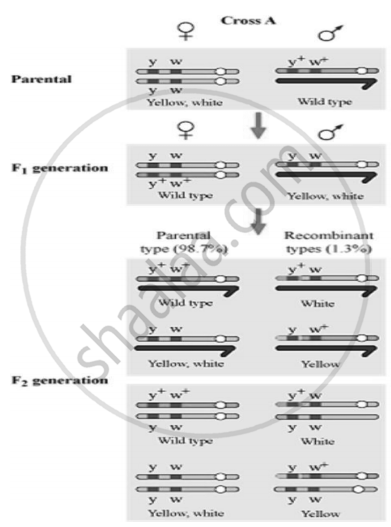Advertisements
Advertisements
Question
A cross between two tall plants resulted in offspring having few dwarf plants. What would be the genotypes of both the parents?
Options
Tt and Tt
TT and Tt
TT and TT
Tt and tt
Solution
Tt and Tt
APPEARS IN
RELATED QUESTIONS
Two heterozygous parents are crossed. If the two loci are linked what would be the distribution of phenotypic features in F1 generation for a dihybrid cross?
Filling the blank based on the given relationship.
3 : 1 Monohybrid : : 9 : 3 : 3 : 1 : ______
Give Technical Term:
The ratio of offspring on F2 generation in a dihybrid cross.
The physical expression of a gene is called ______.
Explain with an example the inheritance of the dihybrid cross. How is it different from monohybrid cross?
In pea plants, yellow seeds are dominant to green. If a heterozygous yellow seed pant is crossed with a green seeded plant, what ratio of yellow and green seeded plants would you expect in the F1 generation?
The genotype of a plant showing the dominant phenotype can be determined by
Select the correct statement from the ones given below with respect to dihydrid cross
Name the seven contrasting traits of Mendel.
Identify the statementls that is/are NOT the correct reason/s for Mendel's success in his hybridization experiments.
i. Each factor controlled the single trait and is located on separate chromosomes.
ii. In the pea plant, contrasting characters can be easily recognized.
iii. Mendel carefully recorded the number of plants of each type and expressed his results as ratios.
iv. Mendel performed biochemical assays for identifying the position of 'factors' on chromosome.
In a dihybrid cross, if you get 9:3:3:1 ratio it denotes that ______.
Mendel’s last law is ______.
In a dihybrid cross, F2 phenotypic ratio is 13 : 3. It is case of ______.
Two genes ‘A’ and ‘B’ are linked. In a dihybrid cross involving these two genes, the F1 heterozygote is crossed with homozygous recessive parental type (aa bb). What would be the ratio of offspring in the next generation?
Assertion: When the two genes in a dihybrid cross are situated on the same chromosome, the proportion of parental gene combinations is much higher than the nonparental type.
Reason: Higher parental gene combinations can be attributed to crossing over between two genes.
Given below is a dihybrid cross performed on Drosophila.

Which of the following conclusions can be drawn on the basis of this cross? When yellow bodied (y), white-eyed (w) Drosophila females were hybridized with brown bodied (y+), red-eyed males (w+) and F1 progenies were intercrossed, F2 generation would have shown the following ratio:
How is the sex of a newborn determined in humans?
Sahil performed an experiment to study the inheritance pattern of genes. He crossed tall pea plants (TT) with short pea plants (tt) and obtained all tall plants in F1 generation.
Give a reason why only tall plants are observed in F1 progeny.
Sahil performed an experiment to study the inheritance pattern of genes. He crossed tall pea plants (TT) with short pea plants (tt) and obtained all tall plants in F1 generation.
When F1 plants were cross-pollinated with plants having tt genes, a total of 800 plants were produced. How many of these would be tall, medium height or short plants? Give the genotype of F2 generation.
The Law of independent assortment is applicable for the traits which ______
